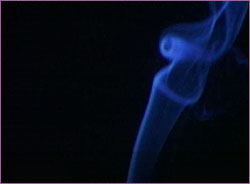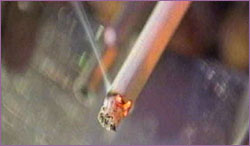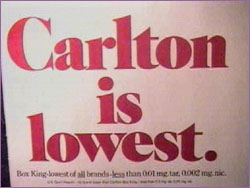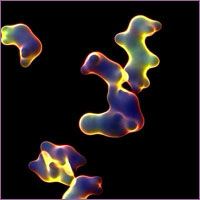|

|

|
|
|
 With all the heat they've taken for promoting
smoking, cigarette manufacturers have spent fortunes
trying to develop a "safer" cigarette.
With all the heat they've taken for promoting
smoking, cigarette manufacturers have spent fortunes
trying to develop a "safer" cigarette.
|
"Safer" Cigarettes: A History
by Tara Parker-Pope
Although the cigarette industry has spent much of the past
50 years denying a link between smoking and disease, the
industry has also dedicated a significant amount of time and
money to develop a "safe" cigarette. A safe cigarette that
can both satisfy smokers' demands for taste and nicotine
delivery and placate public health concerns is the Holy
Grail of the tobacco industry. The company that comes up
with it first likely could dominate the entire industry by
selling the newfangled smoke at a significant premium and
grabbing market share from its competitors. Indeed, in the
1950s, Philip Morris researchers already saw the potential
of a "healthy" cigarette and had even begun to suggest that
the company could capitalize on health concerns by admitting
that cigarettes were harmful. "Evidence is building up that
heavy smoking contributes to lung cancer," wrote a Philip
Morris scientist in July 1958. He then suggested that the
company have the "intestinal fortitude to jump to the other
side of the fence," and that the company would have a
"wealth of ammunition" to attack competitors who did not
have safer cigarettes.
But several factors have stood in the way of the development
of a safer smoke. Taking the toxins out of cigarette smoke
has turned out to be a technological challenge. The biggest
problem has been maintaining the taste and smoking
sensations that smokers crave—so far, no company has
overcome those obstacles. And industry lawyers have balked
at the suggestions that cigarette makers embark on research
to make safe cigarettes out of fears of the tricky legal
problem such research would create for the entire industry.
Patrick Sheehy, the former chief executive of British
American Tobacco, wrote in 1986 that safe cigarette research
would be tacit admission that cigarettes are dangerous. "In
attempting to develop a "safe" cigarette you are, by
implication, in danger of being interpreted as accepting the
current product is unsafe, and this is not a position that I
think we should take," he wrote.
 Among cigarette manufacturers, finding a way to
remove toxins from cigarette smoke is, well, a burning
desire.
Among cigarette manufacturers, finding a way to
remove toxins from cigarette smoke is, well, a burning
desire.
|
|
Finally, the safe cigarette has been stymied by the very
groups who are most concerned about the health effects of
smoking: antitobacco groups and public health officials. The
cigarette industry's efforts to market safer cigarettes have
been met with fierce opposition by antitobacco activists,
who want to see such products labeled as nicotine delivery
devices and subjected to government regulations. Although
the opposition of health groups to a safe cigarette would
seem contradictory, it is borne out of a deep mistrust of
the cigarette companies, whose strategy of denial over the
years has created a credibility gap with the public health
community.
The "tar derby"
The cigarette makers first began making noises about safer
cigarettes in the 1950s during a period now known among
historians as the "tar derby." As a result of growing public
concerns about smoking and health, the cigarette makers
responded with a variety of new filter cigarettes that would
ostensibly reduce tar levels. But the rise of the filter
cigarette was more a marketing ploy than anything else.
There was little evidence to suggest that filter cigarettes
were any healthier than regular cigarettes, and the tobacco
companies' own researchers knew this to be the case. A 1976
memo from Ernest Pepples, Brown & Williamson's vice
president and general counsel, noted that filter cigarettes
surged from less than 1 percent of the market in 1950 to 87
percent in 1975. "In most cases, however, the smoker of a
filter cigarette was getting as much or more nicotine and
tar as he would have gotten from a regular cigarette. He had
abandoned the regular cigarette, however, on the ground of
reduced risk to health," wrote Pepples.
|
 One of the competitors in the "tar derby."
One of the competitors in the "tar derby."
|
Even today, many smokers think that low-tar or so-called
light or ultra-light cigarettes are better for them than
full-strength smokes. Because reducing tar levels also tends
to lower nicotine levels, studies have shown that smokers
inadvertently compensate for the loss of the nicotine.
Smokers of low-tar cigarettes inhale more deeply, take puffs
more often, and even cover up the tiny holes near the filter
that were put there to reduce the amount of smoke, and
subsequently the amount of tar, that a smoker inhales. (To
take a closer look at ventilation holes and other design
elements in today's cigarettes, see
Anatomy of a Cigarette.)
Toward "safer" smokes
During the 1960s cigarette makers embarked on extensive
research to create a safe cigarette. The goal was to remove
the toxins from a conventional cigarette without altering
the taste or smoking experience. Memos from that time period
show that some tobacco company executives were genuinely
interested not only in profits but in making their products
healthier. In 1962, Charles Ellis, a British American
Tobacco research executive, noted that painting mice with
"fresh" smoke condensate, more similar to the "fresh" smoke
inhaled by smokers, might prove to be more harmful than the
older, stored condensate often used in such experiments.
"This possibility need not dismay us, indeed it would mean
that there really was a chemical culprit somewhere in smoke,
and one, moreover, that underwent a reaction fairly quickly
to something else. I feel confident that in this case we
could identify this group of substances, and it would be
worth almost any effort, by preliminary treatment,
additives, or filtration, to get rid of it."
Industry documents show that tobacco companies focused their
safe-cigarette research on several areas, including the
development of synthetic tobacco, boosting nicotine levels
in low-tar cigarettes (so smokers wouldn't have to
compensate for a loss of nicotine), and selective filtration
of the most toxic substances in cigarette smoke, such as
carbon monoxide. Research into safe cigarettes also has
focused on the removal or lowering of four types of
carcinogenic compounds: nitrosamines, widely viewed as the
most deadly cancer-causing agents in tobacco smoke;
aldehydes, formed by the burning of sugars and cellulose in
tobacco; polycyclic aromatic hydrocarbons (PAH's), which
form in the cigarette behind the burning tip; and traces of
heavy metals present in tobacco as a result of fertilizers
used on the plant.
 This animation shows how the heat from tobacco
combustion causes molecules to fragment into unstable
arrangements, which recombine to form carcinogenic
compounds of polycyclic aromatic hydrocarbons, or
PAH's.
This animation shows how the heat from tobacco
combustion causes molecules to fragment into unstable
arrangements, which recombine to form carcinogenic
compounds of polycyclic aromatic hydrocarbons, or
PAH's.
See the animation in:
QuickTime
|
RealVideo
Get video software:
QuickTime
|
RealVideo
|
|
But despite the industry's early optimism about simply
removing the toxic elements from a cigarette, the quest for
a safe cigarette proved to be a technically and politically
daunting challenge. Industry researchers often found ways of
lowering one or two of the dangerous compounds, only to
discover that their tinkering had either increased the level
of some other harmful compound or so dramatically altered
the cigarette that it wouldn't be accepted by consumers. In
1975, Brown & Williamson introduced a new cigarette,
Fact, which had been designed to selectively remove certain
compounds, including cyanide, from cigarette smoke. But the
product was pulled from the market after just two years.
Scientists also experimented with tobacco substitutes,
including ingredients made with wood pulp, that were said to
be less toxic than tobacco. But those products ran into a
new set of problems because they were no longer a naturally
occurring tobacco product but a synthetic creation about
which health claims were being made. That meant government
regulators viewed the tobacco substitutes more like drugs,
subjecting them to a regulatory morass that the cigarette
makers wanted to avoid. In 1977, a few British tobacco
companies, Imperial, Gallaher, and Rothmans, which could
avoid U.S. Food and Drug Administration scrutiny, launched
several versions of cigarettes made with tobacco
substitutes. But the products met with resistance from
health groups, who claimed the new cigarettes were still
unsafe, and the products floundered and were withdrawn after
just a few months.
Continue: The XA Project

|

|
Anatomy of a Cigarette
|
"Safer" Cigarettes: A History
|
The Dope on Nicotine
|
On Fire
Resources
|
Teacher's Guide
|
Transcript
|
Site Map
|
Search for a Safe Cigarette Home
Search |
Site Map
|
Previously Featured
|
Schedule
|
Feedback |
Teachers |
Shop
Join Us/E-Mail
| About NOVA |
Editor's Picks
|
Watch NOVAs online
|
To print
PBS Online |
NOVA Online |
WGBH
©
| Updated October 2001
|
|
|
|